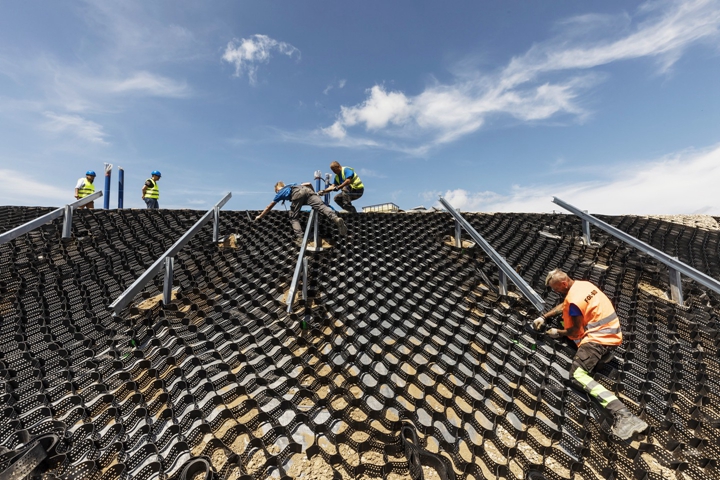Poland's Green Revolution
Text and photos by Bruno Zanzottera/Parallelozero
Abridged by Syharn Shen (沈思含)
Poland's Green Revolution
Text and photos by Bruno Zanzottera/Parallelozero
Abridged by Syharn Shen (沈思含)

In Ceglowo, Poland, Soviet-era Ceramik housing units have been regenerated with photovoltaic panels and heat pump systems.
In Poland, a traditionally coal-reliant country, the war in Ukraine and the ensuing energy crisis have hastened a shift towards renewable energy, particularly through the adoption of heat pumps and the retrofitting of Soviet-era buildings. This move, primarily driven by a desire to reduce dependency on Russian fossil fuels, is also enhancing local economies and creating jobs.
The groundwork for this transition was laid even before the war, originating from grassroots efforts in tenant associations of prefab buildings, common during the Communist era. These buildings, often inefficient and costly to heat, began to undergo transformations to improve energy efficiency and reduce heating costs. A notable example is in Szczytno, where residents, initially skeptical, embraced insulation and renewable energy sources, leading to significant savings and improved living conditions.

A Soviet-era housing unit in Szczytno, Poland, has been transformed with the addition of photovoltaic panels on balconies and roof, along with a heat pump system.
Adam Duraj, an entrepreneur who started importing and installing heat pumps in the Olsztyn area, played a pivotal role in this transformation. His projects, like the one at Śląska Street, led to buildings becoming self-sufficient in heat and electricity production, independent of coal-fired plants. This model was replicated in other areas, such as Ceglowo, demonstrating the feasibility and benefits of such retrofitting.
These initiatives proved particularly advantageous when energy prices surged due to the Ukraine war, as residents of retrofitted buildings were shielded from the impacts. The environmental benefits were notable too, as exemplified by residents like Bozena Wasiak and Ewa Adamowicz, who highlighted the enhanced warmth and cleaner air post-modernization.
Poland's energy landscape is evolving. Despite being a major coal producer, the country has been diversifying its energy sources. Joanna Maćkowiak-Pandera, CEO of Forum Energii, emphasized the shift towards electrification, spurred on by the war in Ukraine. In 2022, Poland saw a significant decline in coal usage, partly due to the EU's sanctions on Russian fossil fuels, but also due to a growing number of environmentally conscious decisions at the individual level.

The large lignite mine dominates the landscape in Kleszczów, Poland, with the electric power plant visible in the background, showcasing the continued prevalence of coal mining in the country.
The market for heat pumps in Poland is booming, with one in three heating systems in the country now being a heat pump, and two in three for new houses. This surge is supported by both foreign and Polish manufacturers, like Robert Galara's company Galmet, which has evolved from producing fossil fuel stoves to manufacturing heat pumps.
Companies like Euros Energy are not only manufacturing heat pumps but are also involved in comprehensive retrofitting projects. These projects include insulation, installation of heat pumps, photovoltaic panels, and modernizing heating systems. Their approach offers energy independence at a fixed price, making it financially feasible for residents.
Large-scale retrofitting initiatives are underway in various towns and villages, demonstrating a growing trend towards energy independence and sustainability. In Lidzbark Warmiński, Euros Energy is developing a "District Heat Plant of the Future," primarily based on heat pumps and photovoltaic energy, set to supply renewable heat and hot water to a large residential area.

Workers are busy on the embankment in Lidzbark Warmiński, Poland, part of the construction for the experimental Heating Pump of the Future plant, which will provide heating to several housing units once completed.
Joanna Pandera optimistically notes the potential for Poland to phase out coal completely by 2035. This sentiment is echoed in the transformation seen in Bełchatów, a major lignite mining region, where residents are increasingly adopting renewable energy sources, backed by significant subsidies.
In conclusion, Poland's shift towards renewable energy, particularly through the adoption of heat pumps and retrofitting of old buildings, represents a significant move towards energy independence, economic growth, and environmental sustainability, driven by both necessity and a growing ecological awareness.
Contact Us | Plan a Visit | Donate
8 Lide Road, Beitou 11259, Taipei, Taiwan
886-2-2898-9999
005741@daaitv.com
©Tzu Chi Culture and Communication Foundation
All rights reserved.
